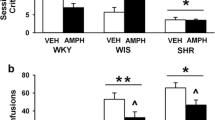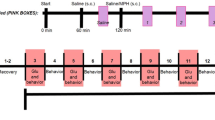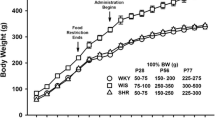Abstract
Attention-deficit hyperactivity disorder (ADHD) is a behavioural disorder that has been suggested to result from disturbances in the dopaminergic system of the brain. The most effective drugs used to treat ADHD are the psychostimulants, methylphenidate and amphetamine. They block dopamine transporters and increase dopamine release, thereby increasing the extracellular concentration of dopamine and altering dopamine signaling. Drugs of abuse, such as cocaine, also block dopamine transporters, which raises the concern that treatment of children with ADHD with psychostimulants might increase their susceptibility to drug addiction. The present study was aimed at investigating whether treatment with methylphenidate at an early stage of development increased preference for ethanol in a widely used rat model for ADHD, the spontaneously hypertensive rat (SHR). SHR display the three major characteristics of ADHD (hyperactivity, impulsivity, poor sustained attention) compared to their progenitor Wistar-Kyoto (WKY) rat strain. Ethanol increased locomotor activity of SHR slightly more than WKY when injected intraperitoneally (0.6 g/kg). SHR also spent more time in the inner zone of the open field than WKY, consistent with SHR being less anxious than WKY. When given free access to ethanol-containing solutions of increasing concentration, SHR consumed less ethanol than WKY. Treatment with methylphenidate at an early age (P21 to P35) did not alter ethanol consumption in adult SHR or WKY, suggesting that it does not increase susceptibility to ethanol addiction in these rats. In vitro superfusion studies further demonstrated that preadolescent methylphenidate treatment did not have long-term effects on dopamine release in adult SHR and WKY striatum. A major finding of this study is the fact that methylphenidate treatment did not increase alcohol use in SHR.





Similar content being viewed by others
References
Bailey CP, O’Callaghan MJ, Croft AP, Manley SJ, Little HJ (2001) Alterations in mesolimbic dopamine function during the abstinence period following chronic alcohol consumption. Neuropharmacology 41:989–999
Brandon CL, Marinelli M, Baker LK, White FJ (2001) Enhanced reactivity and vulnerability to cocaine following low dose exposure to methylphenidate in adolescent rats. Neuropsychopharmacology 25:651–661
Carlezon WA, Mague SD, Andersen SL (2003) Enduring behavioral effects of early exposure to methylphenidate in rats. Biol Psychiatry 54:1330–1337
Cierpial MA, Shasby DE, Murphy CA, Borom AH, Stewart RE, Swithers SE, McCarty R (1989) Open-field behavior of spontaneously hypertensive and Wistar-Kyoto normotensive rats: effects of Reciprocal Cross-Fostering. Behav and Neural Biol 51:203–210
Da Silva GE, Ramos A, Takahashi RN (2004) Comparison of voluntary ethanol intake by two pairs of rat lines used as genetic models of anxiety. Brazil Med Biol Res 37:1511–1517
Da Silva GE, Vendruscolo LF, Takahashi RN (2005) Effects of ethanol on locomotor and anxiety-like behaviors and the acquisition of ethanol intake in Lewis and spontaneously hypertensive rats. Life Sci 77:693–706
Dresel S, Krause J, Krause KH, LaFougere C, Brinkbäumer K, Kung HF, Hahn K, Tatsch K (2000) Attention deficit hyperactivity disorder: binding of [99mTc] TRODAT-1 to the dopamine transporter before and after methylphenidate treatment. Euro Nucl Med 27:1518–1524
Elia J, Ambrosini PJ, Rapoport JL (1999) Treatment of attention deficit-hyperactivity disorder. N Engl J Med 340:780–788
Gatley SJ, Volkow ND, Grifford AN, Fowler JS, Dewey SL, Ding YS, Logon J (1999) Dopamine-transporter occupancy after intravenous doses of cocaine and methylphenidate in mice and humans. Psychopharmacology 146:93–100
Gayton O, Yang P, Swann A, Dafny N (2000) Diurnal differences in sensitization to methylphenidate. Brain Res 864:24–39
Kirouac GJ, Ganguly PK (1992) Up-regulation of dopamine receptors in the brain of the spontaneously hypertensive rat: an autoradiographic analysis. Neuroscience 52:135–141
Kollins SH (2003) Comparing the abuse potential of methylphenidate versus other stimulants: a review of available evidence and relevance to the ADHD patient. J Clin Psychiatry 64:14–18
Kuczenski R, Segal DS (2005) Stimulant action in rodents: implications for attention-deficit/ hyperactivity disorder treatment and potential substance abuse. Biol Psychiatry 57:1391–1396
Narahashi T, Aistrup GL, Marszalec W, Nagata K (1999) Neuronal nicotinic acetylcholine receptors: a new target site for ethanol. Neurochem Internat 35:131–141
Nestby P, Vanderchuuren LJMJ, De Vries TJ, Mulder AH, Wardeh G, Hogenboom F, Schoffelmeer ANM (1999) Unrestricted free-choice ethanol self-administration in rats causes long-term neuroadaptations in the nucleus accumbens and caudate putamen. Psychopharmacology 141:307–314
Okamoto K, Aoki K (1963) Development of a strain of spontaneously hypertensive rats. Jpn Circ J 27:282–293
Paxinos G, Watson C (2005) The rat brain in stereotaxic coordinates, 5th edn. Elsevier Academic, New York
Richelson E, Pfenning M (1984) Blockade by antidepressants and related compounds of biogenic amine uptake into rat brain synaptosomes: most antidepressants selectively block norepinephrine uptake. Eur J Pharmacol 104:227–86
Rosa-Neto P, Lou HC, Cumming P, Pryds O, Karrebaek H, Lunding J, Gjedde A (2005) Methylphenidate- evoked changes in striatal dopamine correlate with inattention and impulsivity in adolescents with attention deficit hyperactivity disorder. NeuroImage 25:868–876
Russell V, de Villiers A, Sagvolden T, Lamm M, Taljaard J (1995) Altered dopaminergic function in the prefrontal cortex, nucleus accumbens and caudate-putamen of an animal model of attention-deficit hyperactivity disorder—the spontaneously hypertensive rat. Brain Res 676:343–351
Russell VA, Lamm MC, de Villiers AD, Reyneke L, Taljaard JJF (1996) [3H] dopamine and [14C] acetylcholine release from rat prefrontal cortex, nucleus accumbens and caudate-putamen slices. Neurosci Prot 96-060-05-01-18
Russell VA, de Villiers A, Sagvolden T, Lamm M, Taljaard J (1998) Differences in electrically-, ritalin and D-amphetamine-stimulated release of [3H]dopamine from brain slices suggest impaired vesicular storage of dopamine in an animal model of attention-deficit hyperactivity disorder. Behav Brain Res 94:163–171
Russell VA, de Villiers AS, Sagvolden T, Lamm MCL, Taljaard JJF (2000) Methylphenidate affects striatal dopamine differently in an animal model for attention-deficit/hyperactivity disorder—the spontaneously hypertensive rat. Brain Res Bull 53:187–192
Russell VA, Sagvolden T, Johansen EB (2005) Animal models of attention-deficit hyperactivity disorder. Behav Brain Funct 1:1–17
Sagvolden T (2000) Behavioural validation of the spontaneously hypertensive rat (SHR) as an animal model of attention-deficit/hyperactivity disorder (AD/HD). Neurosci Biobehav Rev 24:31–39
Sagvolden T, Russell VA, Aase H, Johansen EB, Farshbaf M (2005) Rodent Models of attention-deficit/hyperactivity disorder. Biol Psychiatry 57:1239–1247
Seeman P, Madras B (2002) Methylphenidate elevates resting dopamine which lowers the impulse-triggered release of dopamine: a hypothesis. Behav Brain Res 130:70–83
Söderpalm B, Ericson M, Olausson P, Blomqvist O, Engel JA (2000) Nicotinic mechanisms involved in the dopamine activating and reinforcing properties of ethanol. Behav Brain Res 113:85–98
Stromberg MF, Volpicelli JR, O’Brian CP (1998) Effects of naltrexone administered repeatedly across 30 or 60 days on ethanol consumption using a limited access procedure in the rat. Alcohol Clin Exp Res 22:2186–2191
Sue D, Sue DW, Sue S (2000) Disorders of childhood. Understanding abnormal behaviour, 6th edn. Houghton Mifflin Company, New York, pp 478–515
Valenzuela CF (1997) Alcohol neurotransmitter interactions. Alcohol Health Res World 21:144–148
Volkow ND, Insel TR (2003) What are the long-term effects of methylphenidate treatment? Biol Psychiatry 54:1307–1309
Volkow ND, Wang GJ, Fowler JS, Logan J, Gerasimov M, Maynard L, Ding YS, Gatley SJ, Grifford A, Franceschi D (2001) Therapeutic doses of oral methylphenidate significantly increase extracellular dopamine in the human brain. Neuroscience 21:1–5
Wheeler TL, Eppolito AK, Smith LN, Huff TB, Smith RF (2007) A novel method for oral stimulant administration in the neonate rat and similar species. J Neurosci Methods 159:282–285
Wilens TE, Faraone SV, Biederman J, Gunawardene S (2003) Does stimulant therapy of attention-deficit/hyperactivity disorder beget later substance abuse? A meta-analytic review of the literature. Pediatrics 111:179–185
Acknowledgments
This work was supported by the Medical Research Council of South Africa and the University of Cape Town. The authors wish to thank Mr Leander Bindewald and Mr Letlhogonolo Selaledi for technical assistance.
Author information
Authors and Affiliations
Corresponding author
Rights and permissions
About this article
Cite this article
Soeters, H.S., Howells, F.M. & Russell, V.A. Methylphenidate does not increase ethanol consumption in a rat model for attention-deficit hyperactivity disorder—the spontaneously hypertensive rat. Metab Brain Dis 23, 303–314 (2008). https://doi.org/10.1007/s11011-008-9098-1
Received:
Accepted:
Published:
Issue Date:
DOI: https://doi.org/10.1007/s11011-008-9098-1




